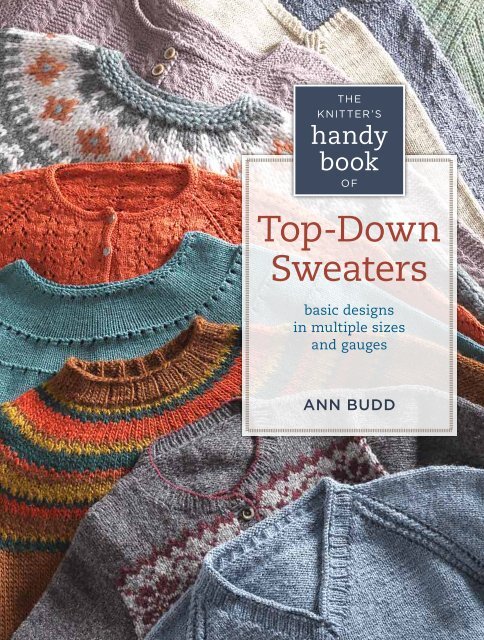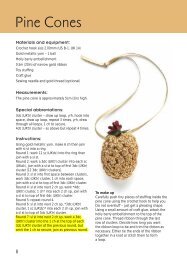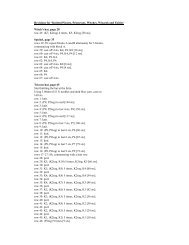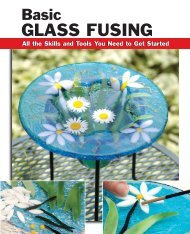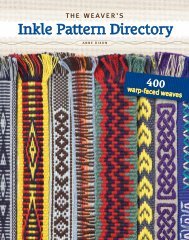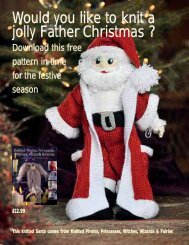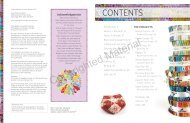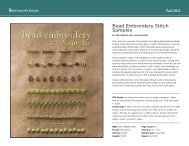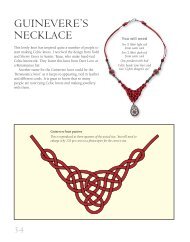Look inside - Search Press
Look inside - Search Press
Look inside - Search Press
You also want an ePaper? Increase the reach of your titles
YUMPU automatically turns print PDFs into web optimized ePapers that Google loves.
the<br />
knitter’s<br />
handy<br />
book<br />
of<br />
Top-Down<br />
Sweaters<br />
basic designs<br />
in multiple sizes<br />
and gauges<br />
Ann Budd
circular<br />
yoke<br />
Feather and<br />
Fan Flare<br />
set-in<br />
sleeve<br />
Alpine<br />
Tweed<br />
saddle<br />
shoulder<br />
Zigs & Zags<br />
set-in<br />
sleeve<br />
Golden Ribs<br />
and Welts
H ow to<br />
Use this Book<br />
Instructions<br />
for each sweater<br />
style are divided into “child” sizes of<br />
26"–34" (66–86.5 cm) chest circumference,<br />
“women’s” sizes of 36"–44" (91.5–112 cm)<br />
bust circumference, and “men’s” sizes of<br />
46"–54" (117–137 cm) chest circumference.<br />
The overall sweater measurements are listed<br />
in the box on the first page of the project.<br />
Of course, depending on the amount of ease<br />
you want in the finished sweater, it’s quite<br />
possible to follow a child’s or a man’s size<br />
for a woman’s sweater. Each sweater style<br />
contains two full sets of instructions—the<br />
five child sizes followed by the ten adult (five<br />
women and five men) sizes. Keep in mind<br />
that the men’s sizes have slightly deeper<br />
armholes than women’s sweaters of similar<br />
circumferences would normally have.<br />
The instructions are broken down line by<br />
line, with each line followed by a chart, or<br />
grid, with the possible sizes (based on finished<br />
chest/bust circumference) in columns<br />
and the possible gauges (in stitches per inch)<br />
in rows. For each line of instructions, simply<br />
find your gauge along the left margin of the<br />
chart and follow that row across to the column<br />
that matches your size.<br />
For example, let’s say you want to make a<br />
circular yoke sweater with a finished chest<br />
measurement of 42" (106.5 cm) at a gauge of<br />
5 stitches to the inch. According to the adult<br />
circular yoke sweater chart on page 12, you’d<br />
follow the third row of numbers (for a gauge<br />
of 5 stitches to the inch) and the fourth<br />
column of numbers (for a finished size of<br />
42" [106.5 cm]). For this example, you’d cast<br />
on 80 stitches for the neck. You may find it<br />
helpful to circle or highlight the numbers<br />
that apply to your size and gauge (on a<br />
photocopy of the pages if you don’t want to<br />
write in the book) before you begin. When<br />
there is just one row of numbers, it applies<br />
to all gauges.<br />
All the instructions in this book were<br />
devised by calculating how many stitches<br />
would be needed to achieve a knitted piece<br />
of specific dimensions, represented by<br />
schematics. Refer to the schematics that<br />
accompany each sweater style to check<br />
your progress and assure that your piece is<br />
working out to the measurements specified.<br />
If you’re unsure about which size is best for<br />
you, take a look at the accompanying schematic—it<br />
is a graphic representation of the<br />
finished garment.<br />
3
Raglan Sweaters<br />
Sweaters<br />
with raglan shaping<br />
are distinctive in the “seams” between the<br />
front(s), back, and sleeves that form diagonal<br />
lines that run from the neck edge to the base<br />
of the armholes. Beginning at the neck, the<br />
number of stitches on the front(s), back, and<br />
sleeves increase at regular intervals along<br />
these lines to give each section a triangular<br />
shape. The raglan lines can be decorative or<br />
inconspicuous, depending on the type and<br />
sequence of increases used. Raglan sweaters<br />
fit well at the shoulders and lend themselves<br />
well to a close fit or waist shaping (see waist<br />
shapings on page 21), such as worked in<br />
Weekday Raglan (page 26). The raglan lines<br />
provide a nice structure for textural design<br />
elements, such as the openwork patterns in<br />
A Twisted Little Raglan (page 32) and India<br />
Print Henley (page 38).<br />
The raglan sweaters in this book begin with<br />
stitches cast on for about three-quarters of<br />
the neck circumference. The neck is worked<br />
back and forth in rows while additional<br />
stitches are cast on at the end of each row<br />
to shape the front neck at the same time<br />
as increases are worked along each of the<br />
four raglan lines to shape the shoulders. At<br />
the base of the front neck, the stitches are<br />
joined and the piece continues in the round<br />
to the base of the armholes for a pullover;<br />
the work continues back and forth in rows<br />
for a cardigan. At the underarms, stitches<br />
for the sleeves are placed on holders and<br />
the front(s) and back are joined with a few<br />
stitches cast on to span the gaps, then the<br />
body is worked in one piece to the hem. The<br />
sleeves are then worked in the round to the<br />
cuffs and tapered with decreases along the<br />
way. Finally, stitches for the neckband/collar<br />
are picked up around the neck opening and<br />
worked as desired.<br />
Finished Size: Finished bust/chest<br />
circumference is listed horizontally across the<br />
top of each page.<br />
Needles: Circular (cir) needles in 16" (40 cm)<br />
and 24" or 32" (60 or 80 cm) lengths and a set<br />
of 4 or 5 double-pointed needles (dpn) in the<br />
size necessary to obtain the desired gauge<br />
(and needles one or two sizes smaller for<br />
edgings, if desired).<br />
Notions: Stitch markers (m); waste yarn or<br />
stitch holders; tapestry needle; buttons for<br />
cardigan versions: typically 5 to 7 for child<br />
sizes or 7 to 9 for adult sizes.<br />
Gauge: Gauge, in 3, 4, 5, 6, or 7 stitches/inch<br />
(2.5 cm), runs vertically along the left side of<br />
each group of numbers.<br />
raglan sweaters<br />
5
Adult Sizes<br />
finished bust/chest circumference<br />
36 38 40 42 44 46 48 50 52 54"<br />
91.5 96.5 101.5 106.5 112 117 122 127 132 137 cm<br />
yarn requirements<br />
raglan<br />
gauge in sts/inch<br />
3<br />
4<br />
5<br />
6<br />
7<br />
570 620 680 730 780 830 870 900 940 980 yd<br />
521 567 622 668 713 759 796 823 860 896 m<br />
810 870 960 1040 1110 1180 1230 1280 1330 1380<br />
741 796 878 951 1015 1079 1125 1170 1216 1262<br />
1020 1100 1210 1310 1400 1480 1550 1610 1680 1740<br />
933 1006 1106 1198 1280 1353 1417 1472 1536 1591<br />
1440 1560 1710 1850 1970 2100 2190 2280 2380 2470<br />
1317 1426 1564 1692 1801 1920 2003 2085 2176 2259<br />
1590 1710 1880 2030 2170 2310 2420 2510 2620 2710<br />
1454 1564 1719 1856 1984 2112 2213 2295 2396 2478<br />
Yoke<br />
With cir needle, CO:<br />
3 28 30 30 32 32 34 34 36 36 38 sts.<br />
g a u g e<br />
sts/inch<br />
4 34 36 36 38 40 46 48 50 50 52<br />
5 44 46 48 50 52 60 60 62 64 66<br />
6 50 52 54 56 58 72 74 76 78 80<br />
7 60 64 66 68 70 78 80 84 86 88<br />
Do not join. Rows begin at center front.<br />
Set-up row: With WS facing, purl 1 row and at the same time place marker (pm) after 1 st to<br />
denote left front.<br />
Then place an additional marker after the foll number of sts to denote the left sleeve:<br />
3 4 4 4 4 4 4 4 4 4 4 sts.<br />
4 4 4 4 4 4 6 6 6 6 6<br />
5 6 6 6 6 6 8 8 8 8 8<br />
6 6 6 6 6 6 10 10 10 10 10<br />
7 8 8 8 8 8 10 10 10 10 10<br />
6 the knitter’s handy book of top-down sweaters
finished bust/chest circumference<br />
36 38 40 42 44 46 48 50 52 54"<br />
91.5 96.5 101.5 106.5 112 117 122 127 132 137 cm<br />
Then place an additional marker after the foll number of sts to denote the back:<br />
3 18 20 20 22 22 24 24 26 26 28 sts.<br />
4 24 26 26 28 30 32 34 36 36 38<br />
5 30 32 34 36 38 42 42 44 46 48<br />
6 36 38 40 42 44 50 52 54 56 58<br />
7 42 46 48 50 52 56 58 62 64 66<br />
raglan<br />
Then place an additional marker after the foll number of sts to denote the right sleeve:<br />
3 4 4 4 4 4 4 4 4 4 4 sts.<br />
4 4 4 4 4 4 6 6 6 6 6<br />
5 6 6 6 6 6 8 8 8 8 8<br />
6 6 6 6 6 6 10 10 10 10 10<br />
7 8 8 8 8 8 10 10 10 10 10<br />
There will remain 1 st for right front.<br />
Note: When working yoke, change to longer cir needle as necessary to accommodate the<br />
large number of sts.<br />
Quick Tips for Circular Knitting<br />
••<br />
The advantage to knitting sweaters in<br />
the round is that there are no seams<br />
to sew. However, side seams can help<br />
to stabilize a garment and encourage<br />
it to hang vertically without twisting<br />
or torquing to one side or the other. To<br />
ensure against this tendency, work the<br />
center underarm stitch in a different<br />
stitch pattern, such as garter stitch<br />
(alternate between knitting and purling<br />
these stitches every round), reverse<br />
stockinette stitch (purl these stitches<br />
every round), or slip stitch (slip these<br />
stitches every other round), to cause a<br />
break in the pattern and encourage the<br />
body to hang straight.<br />
••<br />
Sometimes a vertical line of loose<br />
stitches develops at the boundaries<br />
between double-pointed needles.<br />
» quick tip «<br />
raglan sweaters<br />
7
Discover top-down<br />
knitting from the<br />
ground-up<br />
with expert Ann Budd<br />
Ann Budd’s creative ingenuity continues to marvel<br />
fiber and yarn enthusiasts nationwide, and this<br />
latest addition to The Knitter’s Handy Book series<br />
is no exception. Answering to a growing interest in<br />
knitting sweaters from the top down and knitting<br />
seamless sweaters that require little finishing, this<br />
essential book offers instructions for designing<br />
and knitting your own one-of-a-kind top-down<br />
sweaters. Instructions are based on five basic<br />
sweater types (seamless yoke, raglan, modified<br />
drop shoulder, set-in sleeve, and saddle shoulder),<br />
in multiple sizes for both adults and children, and<br />
in multiple yarn gauges. Each of the five sweater<br />
types is conveniently accompanied by three fulllength<br />
patterns, one from a featured top designer.<br />
In this volume, knitters will find the elements<br />
that make any Handy Book a must-have: detailed<br />
charts, clear instruction, how-tos for adding<br />
personal design touches, and quick tips to avoid<br />
mistakes and create flawless final garments.<br />
A key reference for all passionate knitters, The<br />
Knitter’s Handy Book of Top-Down Sweaters is the new<br />
indispensable knitting resource on your bookshelf.<br />
Ann Budd is the best-selling author of Sock Knitting<br />
Master Class, The Knitter’s Handy Book of Patterns, The<br />
Knitter’s Handy Book of Sweater Patterns, Getting Started<br />
Knitting Socks, Interweave Presents Knitted Gifts, Knitting<br />
Green, and Simple Style. She is also the coauthor of<br />
Bag Style, Color Style, Lace Style, and Wrap Style. She is<br />
a book editor and the former senior editor of Interweave<br />
Knits magazine. Visit her at www.annbuddknits.com.<br />
Contents<br />
Introduction: Take It from the Top<br />
Seamless Yoke Sweaters<br />
Child Sizes<br />
Adult Sizes<br />
Projects<br />
• Feather and Fan Flare<br />
• Fibonacci Rings<br />
• “Quince-Essential” Fair Isle<br />
by guest designer Pam Allen<br />
Raglan Sweaters<br />
Child Sizes<br />
Adult Sizes<br />
Projects<br />
• Weekday Raglan<br />
• A Twisted Little Raglan<br />
• India Print Henley<br />
by guest designer Anne Hanson<br />
Modified Drop-Shoulder Sweaters<br />
Child Sizes<br />
Adult Sizes<br />
Projects<br />
• Unisex Zip<br />
• Weekend Retreat<br />
• Basket Case Cardigan<br />
by guest designer Kristen TenDyke<br />
Set-in Sleeve Sweaters<br />
Child Sizes<br />
Adult Sizes<br />
Projects<br />
• Golden Ribs and Welts<br />
• Brioche Basic<br />
• Alpine Tweed<br />
by guest designer Jared Flood<br />
Saddle-Shoulder Sweaters<br />
Child Sizes<br />
Adult Sizes<br />
Projects<br />
• Cable Love Henley<br />
• Retro Peplum<br />
• Zigs & Zags<br />
by guest designer Véronik Avery<br />
Glossary<br />
Sources for Yarns<br />
Bibliography<br />
Hardcover with concealed wire-o<br />
7 × 9¼, 232 pages<br />
ISBN 978-1-59668-483-6<br />
$29.95 • Available July 2012


